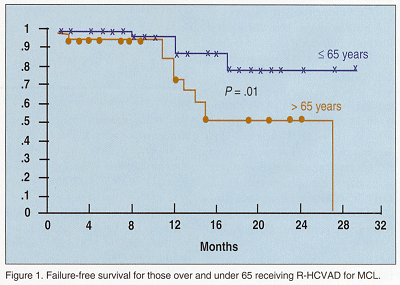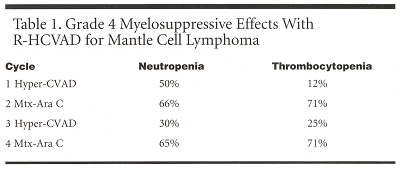Rituximab/Hyper-CVAD Achieves High Complete Responses in Aggressive Mantle Cell Lymphoma
HOUSTON-In patients 65 years or younger with untreated mantle cell lymphoma (MCL), adding rituximab (Rituxan) to the hyper-CVAD/methotrexate/cytarabine (Ara-C) regimen produced high complete remission rates and failure-free survival rates equivalent to those reported for hyper-CVAD followed by stem cell transplants.
HOUSTON-In patients 65 years or younger with untreated mantle cell lymphoma (MCL), adding rituximab (Rituxan) to the hyper-CVAD/methotrexate/cytarabine (Ara-C) regimen produced high complete remission rates and failure-free survival rates equivalent to those reported for hyper-CVAD followed by stem cell transplants.
Results of a trial testing rituximab plus hyperfractionated cyclophosphamide, doxorubicin, vincristine, and dexamethasone (R-HCVAD) without stem cell transplant were presented at the Annual Meeting of The American Society of Hematology by Jorge Romaguera, MD, of The University of Texas M. D. Anderson Cancer Center. Dr. Romaguera cautioned that the data for patients under 65, "while very encouraging, are preliminary, and longer follow-up is warranted to assure this promising therapeutic outcome is sustained."
R-HCVAD also produced high complete remission rates in patients older than 65 with untreated aggressive MCL. In those patients, "the rate of complete remission has improved significantly when compared with CHOP (cyclophosphamide [Cytoxan, Neosar], doxorubicin HCl, vincristine [Oncovin], prednisone)," Dr. Romaguera noted. "The complete remission rate in patients over 65 was also significantly better than that of 68% reported with hyper-CVAD without rituximab. The failure-free survival rate for this subgroup, however, has not improved comparably and new approaches are needed."
Modifying the Regimen
This trial built on a previous one using the hyper-CVAD regimen that included stem cell transplants in patients younger than 66. That trial produced a complete response rate of 100% and prolonged failure-free and overall survival. Eight patients that were eligible for stem cell transplant and did not receive it, but completed six to eight cycles of hyper-CVAD had comparable failure-free survival rates.
The new trial used the hyper-CVAD regimen with two modifications: (1) rituximab at 375 mg/m² was added on day 1 of each cycle; and (2) stem cell transplants were not done for patients achieving complete remission within six courses of treatment.
The study included only untreated patients with aggressive MCL. "Other criteria were standard, including adequate organ function, unless the abnormalities were due to lymphoma," Dr. Romaguera explained. "Patients who were pregnant, had positive HIV status, or presented central nervous system lymphoma were excluded." There was no age limit.
Patient accrual totaled 92. The median age was 61; 35% were over the age of 65, with the oldest treated patient being 80.
Patients presented with advanced disease, mostly on account of bone marrow involvement, but also the involvement of the gastrointestinal tract," Dr. Romaguera reported. "The vast majority of our patients had good performance status and the distribution of histologic types was also typical."
Assessing Response
"Response was systematically assessed after every two treatment cycles with physical examination and radiographic tests, as well as bone marrow biopsies and upper and lower endoscopies," Dr. Romaguera said. "Patients who attained complete remission after the first two cycles received a total of six cycles, while those who attained complete remission after four or six cycles were given a total of eight cycles."
None of the 92 patients have progressed during treatment. "At the present time, 59 of the 92 patients entered in the study have completed at least six cycles, with a complete response rate of 92% for the whole group, independent of age," Dr. Romaguera said.
To explore the correlation of age with outcome, a Kaplan-Meier curve was plotted for failure-free survival. For those 65 and under, "the median failure-free survival has not been reached yet and currently stands at 80% at 2 years follow-up," Dr. Romaguera reported. "In contrast, the median failure-free survival for patients over 65 plateaus between 15 and 27 months." (See Figure 1.)

Kaplan-Meier curves comparing failure-free survival found no statistically significant differences among those 65 years old or younger who received R-HCVAD compared to a similar age group receiving hyper-CVAD followed by stem cell transplant, or among patients older than 65 who received R-HCVAD compared to a similar group who received hyper-CVAD without rituximab.
Most Toxicities Hematologic
As expected, most toxicities were hematologic (see Table 1). "Even though there was a high percentage of grade 4 neutropenia," Dr. Romaguera related, out of more than 140 courses of treatment given, only 11% of episodes were grade 3 or greater infection and the percentage of grade 4 toxicities was small.

There were four toxic deaths. "Unexpectedly," Dr. Romaguera noted, ‘‘three of these four deaths occurred in patients younger than 64 years of age, two of whom were in complete remission at the time of death."
Newsletter
Stay up to date on recent advances in the multidisciplinary approach to cancer.
Highlighting Insights From the Marginal Zone Lymphoma Workshop
Clinicians outline the significance of the MZL Workshop, where a gathering of international experts in the field discussed updates in the disease state.
Expanding Horizons in T-Cell Lymphoma Therapy: Focus on Personalized Treatment Strategies
Several lymphoma experts discuss the current T-cell lymphoma landscape, the need for new therapies, and ongoing research in the space.